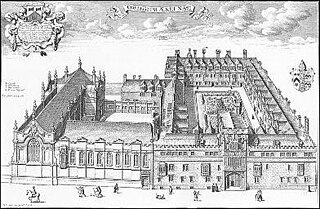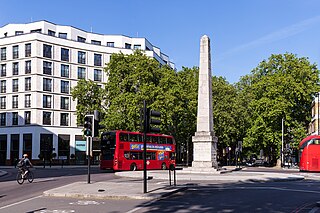
Somerville College, a constituent college of the University of Oxford in England, was founded in 1879 as Somerville Hall, one of its first two women's colleges. Among its alumnae have been Margaret Thatcher, Indira Gandhi, Dorothy Hodgkin, Iris Murdoch, Vera Brittain and Dorothy L. Sayers. It began admitting men in 1994. Its library is one of Oxford's largest college libraries. The college's liberal tone derives from its founding by social liberals, as Oxford's first non-denominational college for women, unlike the Anglican Lady Margaret Hall, the other to open that year. In 1964, it was among the first to cease locking up at night to stop students staying out late. No gowns are worn at formal halls.

The London Borough of Southwark in South London forms part of Inner London and is connected by bridges across the River Thames to the City of London and London Borough of Tower Hamlets. It was created in 1965 when three smaller council areas amalgamated under the London Government Act 1963. All districts of the area are within the London postal district. It is governed by Southwark London Borough Council.

Lady Margaret Hall (LMH) is one of the constituent colleges of the University of Oxford in England, located on a bank of the River Cherwell at Norham Gardens in north Oxford and adjacent to the University Parks. The college is more formally known under its current royal charter as "The Principal and Fellows of the College of the Lady Margaret in the University of Oxford".

St Anne's College is a constituent college of the University of Oxford in England. It was founded in 1879 and gained full college status in 1959. Originally a women's college, it has admitted men since 1979. It has some 450 undergraduate and 200 graduate students and retains an original aim of allowing women of any financial background to study at Oxford. It still has a student base with a higher than average proportion of female students. The college stands between Woodstock and Banbury roads, next to the University Parks. In April 2017, Helen King, a retired Metropolitan Police Assistant Commissioner, took over as Principal from Tim Gardam. Former members include Danny Alexander, Edwina Currie, Ruth Deech, Helen Fielding, William MacAskill, Amanda Pritchard, Simon Rattle, Tina Brown, Mr Hudson and Victor Ubogu.

Samuel Augustus Barnett was a Church of England cleric and social reformer who was particularly associated with the establishment of the first university settlement, Toynbee Hall, in east London in 1884. He is often referred to as Canon Barnett, having served as Canon of Westminster Abbey from 1906 until death.

The University of Oxford has thirty-nine colleges, and four permanent private halls (PPHs) of religious foundation. Colleges and PPHs are autonomous self-governing corporations within the university. These colleges are not only houses of residence, but have substantial responsibility for teaching undergraduate students. Generally tutorials and classes are the responsibility of colleges, while lectures, examinations, laboratories, and the central library are run by the university. Students normally have most of their tutorials in their own college, but often have a couple of modules taught at other colleges or even at faculties and departments. Most colleges take both graduates and undergraduates, but several are for graduates only.

Borough High Street is a road in Southwark, London, running south-west from London Bridge, forming part of the A3 route which runs from London to Portsmouth, on the south coast of England.
The settlement movement was a reformist social movement that began in the 1880s and peaked around the 1920s in the United Kingdom and the United States. Its goal was to bring the rich and the poor of society together in both physical proximity and social connection. Its main object was the establishment of "settlement houses" in poor urban areas, in which volunteer middle-class "settlement workers" would live, hoping to share knowledge and culture with, and alleviate the poverty of, their low-income neighbors. The settlement houses provided services such as daycare, English classes, and healthcare to improve the lives of the poor in these areas. The settlement movement also spawned educational/reform movements. Both in the UK and the US settlement workers worked to develop a unique activist form of sociology known as Settlement Sociology. This science of social reform movement is neglected in the history of sociology in favor of a teaching-, theory- and research university–based model.

Mary Marshall was an economist who in 1874 had been one of the first women to take the Tripos examination at Cambridge University – although, as a woman, she had been excluded from receiving a degree. She was one of a group of five women who were the first to be admitted to study at Newnham College, the second women's college to be founded at the University.
Basil Champneys was an English architect and author whose most notable buildings include Manchester's John Rylands Library, Somerville College Library (Oxford), Newnham College, Cambridge, Lady Margaret Hall, Oxford, Mansfield College, Oxford and Oriel College, Oxford's Rhodes Building.

Borough Road is in Southwark, London SE1. It runs east–west between St George's Circus and Borough High Street.

St George's Circus is a road junction in Southwark, London, England. At its centre, which is now a traffic roundabout, is an historic obelisk, designed by Robert Mylne (1733–1811), in his role as surveyor and architect of Blackfriars Bridge.
Sir Owen John Roberts, JP, DL, DCL, LL.D was a Welsh educationalist, who helped to pioneer technical education in London. He is also a great-grandfather of Antony Armstrong-Jones, 1st Earl of Snowdon, who was the husband of Princess Margaret.

Louise Hume Creighton was a British author of books on historical and sociopolitical topics, and an activist for a greater representation of women in society, including women's suffrage, and in the Church of England.

Madeleine Septimia Shaw Lefevre was the Principal of Somerville Hall from 1879 to 1889. The hall became Somerville College, Oxford in 1894.

Helen Gladstone was a British educationist, vice-principal at Newnham College in Cambridge, and co-founder of the Women's University Settlement.
Alice Gruner (1846–1929) was a lecturer, social worker, and a principal founder of the Women's University Settlement, Southwark.
The Association for the Education of Women or Association for Promoting the Higher Education of Women in Oxford (AEW) was formed in 1878 to promote the education of women at the University of Oxford. It provided lectures and tutorials for students at the four women's halls in Oxford, as well as for female students living at home or in lodgings and was dissolved in 1920 when women were admitted as members of the university.
Margaret Sewell (1852–1937) was an English educator who was Warden of the Women's University Settlement. She was a pioneer advocate of social work.

Tabard Gardens is a small park in Southwark, London. It is located on Tabard Street and gives its name to the surrounding Tabard Gardens Estate. The park was created as part of a slum clearance programme by the London County Council and opened in 1929. It is owned and managed by Southwark Council.














